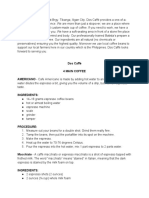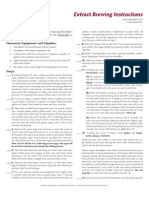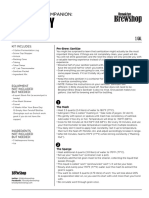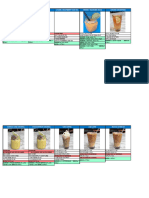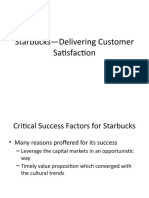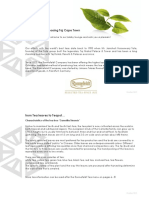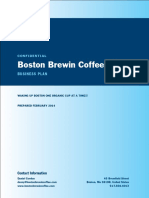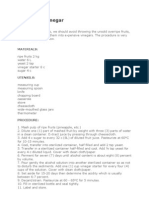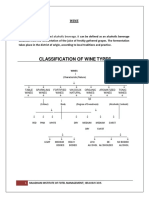0 ratings0% found this document useful (0 votes)
32 viewsWine Making Recipes
Wine Making Recipes
Uploaded by
Irish Jane TabelismaThe document provides instructions for making wine from several different fruits including pineapple, coconut, grapes, and guava. It lists the tools and ingredients needed for each type of wine. The procedures generally involve chopping or extracting the fruit juice, adding sugar and water, inoculating with yeast, fermenting for several weeks, clarifying and aging the wine before bottling. The four wine recipes have similar steps but vary in the specific fruits used and quantities of ingredients.
Copyright:
© All Rights Reserved
Available Formats
Download as DOCX, PDF, TXT or read online from Scribd
Wine Making Recipes
Wine Making Recipes
Uploaded by
Irish Jane Tabelisma0 ratings0% found this document useful (0 votes)
32 views2 pagesThe document provides instructions for making wine from several different fruits including pineapple, coconut, grapes, and guava. It lists the tools and ingredients needed for each type of wine. The procedures generally involve chopping or extracting the fruit juice, adding sugar and water, inoculating with yeast, fermenting for several weeks, clarifying and aging the wine before bottling. The four wine recipes have similar steps but vary in the specific fruits used and quantities of ingredients.
Original Description:
material
Copyright
© © All Rights Reserved
Available Formats
DOCX, PDF, TXT or read online from Scribd
Share this document
Did you find this document useful?
Is this content inappropriate?
The document provides instructions for making wine from several different fruits including pineapple, coconut, grapes, and guava. It lists the tools and ingredients needed for each type of wine. The procedures generally involve chopping or extracting the fruit juice, adding sugar and water, inoculating with yeast, fermenting for several weeks, clarifying and aging the wine before bottling. The four wine recipes have similar steps but vary in the specific fruits used and quantities of ingredients.
Copyright:
© All Rights Reserved
Available Formats
Download as DOCX, PDF, TXT or read online from Scribd
Download as docx, pdf, or txt
0 ratings0% found this document useful (0 votes)
32 views2 pagesWine Making Recipes
Wine Making Recipes
Uploaded by
Irish Jane TabelismaThe document provides instructions for making wine from several different fruits including pineapple, coconut, grapes, and guava. It lists the tools and ingredients needed for each type of wine. The procedures generally involve chopping or extracting the fruit juice, adding sugar and water, inoculating with yeast, fermenting for several weeks, clarifying and aging the wine before bottling. The four wine recipes have similar steps but vary in the specific fruits used and quantities of ingredients.
Copyright:
© All Rights Reserved
Available Formats
Download as DOCX, PDF, TXT or read online from Scribd
Download as docx, pdf, or txt
You are on page 1of 2
PINEAPPLE WINE MAKING
TOOLS, UTENSILS AND EQUIPMENT NEEDED:
Knife
Utility tray
Chopping board
Measuring spoon
Measuring cups
Wooden spoon
Sterilized jar or bottles
Stove
INGREDIENTS:
1pc ripe Pineapple
1 cup Water
¼ cup Sugar
1/8 tablespoon Yeast
PROCEDURE:
1. Pare the pineapple and chop. Measure and add water. (1 part of water to every part of pineapple).
2. Boil until fruits are soft. Cool and strain.
3. Add sugar to the extract (1 part of sugar to every 4 parts of pineapple extract). Stir and boil.
4. Cool and place in a glass container or demijohn (with cotton ping).
5. Inoculates with yeast (1 table spoon yeast to every 4 liters of juice).
6. Ferment for a month. Decant into wine barrels and age for 2 years.
7. Clarify with the use of egg white (8 egg whites forever 30 liters of wine).
8. Proceed as in the clarification of banana wine.
9. Siphon into demijohn filter wine and bottle.
COCONUT WINE MAKING
TOOLS, UTENSILS AND EQUIPMENT NEEDED:
Knife
Utility tray
Chopping board
Measuring spoon
Measuring cups
Wooden spoon
Sterilized jar or bottles
Stove
INGREDIENTS:
2 cups of juice extract of apple
2 cups of Water
1/8 cup Sugar
1/8 tablespoon Yeast
1 pc. Calamansi
PROCEDURE:
1. Mix sugar in 2 cups warm water.
2. Add juice and mx thoroughly.
3. Dissolve yeast in 2 tablespoon warm water then add juice.
4. Add calamansi in juice and mix well.
5. Pour the mixture into the container and then put it in a sterilized bottle for 30 days.
COCONUT WINE MAKING
TOOLS, UTENSILS AND EQUIPMENT NEEDED:
Knife
Utility tray
Chopping board
Measuring spoon
Measuring cups
Measuring glass
Wooden spoon
Sterilized jar or bottles
Hydrometer
Stove
INGREDIENTS:
2 cups coconut water
1/8 cup Sugar
1/8 tablespoon Yeast
PROCEDURE:
1. Strain coconut water and measure. Add sugar for every 5-parts coconut water, add 1 ½ parts sugar.
2. Stir and boil to dissolve the sugar. Measure sugar content by means of hydrometer to produce 22-23 brix.
3. Allow to cool and place in glass jar or demijohn.
4. Cover mouth with cotton or clean cloth. Closely cover with proper to protect from dust.
5. Maculate with 2 tablespoon yeasts to every liter of the sweetened juice.
6. Let ferment for about one wine with egg (8 egg white for every 20 liters wine
7. Siphoning into clear and sterilized bottles.
GRAPES WINE MAKING
TOOLS, UTENSILS AND EQUIPMENT NEEDED:
Knife
Utility tray
Colander
Chopping board
Measuring spoon
Measuring cups
Measuring glass
Wooden spoon
Sterilized jar or bottles
Hydrometer
Stove
INGREDIENTS:
2 cups of Juice extract
2 cups of Water
1/8 cup Sugar
1/8 tablespoon Yeast
1 pc Calamansi
PROCEDURE:
1. Mix sugar in 2 cups warm water.
2. Add juice and mix thoroughly.
3. Dissolve yeast in 2 tablespoon warm water then add juice.
4. Add calamansi in juice and mix well
5. Pour the mixture into the container and then put it in a bottle for 30 days.
GUAVA WINE MAKING
TOOLS, UTENSILS AND EQUIPMENT NEEDED:
Knife
Utility tray
Colander
Chopping board
Measuring spoon
Measuring cups
Measuring glass
Wooden spoon
Sterilized jar or bottles
Hydrometer
Stove
INGREDIENTS:
3 cups of juice extract
3 cups of Water
1 cup Sugar
1 tablespoon Yeast
1 pc Egg (egg white)
PROCEDURE:
1. Select ripe and sound fruits. Cut into quarters. To 1 part add 3 parts waters.
2. Boil until the fruits are soft.
3. Strain and measure the extract. To every 3 parts extracts, add 1 part sugar.
4. Stir and heat the extract. Cool.
5. To every 3 parts extracts, add 1 tablespoon yeast.
6. Place in demijohns to ferment. Fermentation will last from 2-4 weeks.
7. When fermentation is completed, transfer into oak barrels and age for 2 years.
8. Clarify the wine with egg white. Proceed as in the clarification of kasuy wine.
9. Filter the wine and bottle by siphoning into clean sterilized bottles.
You might also like
- Business Plan For Winery From Blue BeryDocument27 pagesBusiness Plan For Winery From Blue Berysamadhandamdhar6109100% (2)
- EBook - English For WineDocument87 pagesEBook - English For WineLeyre Segura Azcune100% (1)
- Hank'S Hefeweizen: Read All Instructions Before StartingDocument2 pagesHank'S Hefeweizen: Read All Instructions Before StartingBhagavanNo ratings yet
- This Study Resource Was: Optm 6090 Operations ManagementDocument7 pagesThis Study Resource Was: Optm 6090 Operations ManagementVishal PatelNo ratings yet
- First Steps in Wine MakingDocument134 pagesFirst Steps in Wine MakingElizabeth Heck100% (3)
- Ginger Beer and Ale RecipeDocument2 pagesGinger Beer and Ale RecipeLenSmithNo ratings yet
- How To Make A Glass of Coffee MaterialsDocument4 pagesHow To Make A Glass of Coffee MaterialsMogami AnnNo ratings yet
- Toddy Retail Instructions UnlockedDocument12 pagesToddy Retail Instructions UnlockedEsteban MorenoNo ratings yet
- American Pale AleDocument2 pagesAmerican Pale AleJustin GarciaNo ratings yet
- Midwest Honeybee AleDocument2 pagesMidwest Honeybee AleJesso GeorgeNo ratings yet
- Best Practices Three Cup French PressDocument2 pagesBest Practices Three Cup French PressEscriNo ratings yet
- Dos CaffeDocument3 pagesDos CaffeJorgie SolerNo ratings yet
- Best Practices Three Cup French Press 2Document2 pagesBest Practices Three Cup French Press 2yasir.19297No ratings yet
- Plastic Repair 2024Document25 pagesPlastic Repair 2024karthiNo ratings yet
- Extract Brewing Instructions: Necessary Equipment and SuppliesDocument2 pagesExtract Brewing Instructions: Necessary Equipment and SuppliesHenry Clark TravagliniNo ratings yet
- Brooklyn Brew Shop Everyday IPA InstructionsDocument3 pagesBrooklyn Brew Shop Everyday IPA InstructionsCarlos Hernandez MontesNo ratings yet
- AG INS BlazingSaizonDocument2 pagesAG INS BlazingSaizonMario JammaersNo ratings yet
- Choco & Coffee FrappeDocument13 pagesChoco & Coffee Frappedyodyo panganibanNo ratings yet
- Book2 (Version 1)Document12 pagesBook2 (Version 1)nnano0773No ratings yet
- Instructional Set - French PressDocument5 pagesInstructional Set - French PressAbigail WilliamsNo ratings yet
- How To Make Cold Brew CoffeeDocument2 pagesHow To Make Cold Brew CoffeeMaru PabloNo ratings yet
- Re:fuel Cafe by AloftDocument10 pagesRe:fuel Cafe by AloftCassandra MazurNo ratings yet
- PF - Beverage Cheat Sheets April 2023Document6 pagesPF - Beverage Cheat Sheets April 2023bertacaraltoNo ratings yet
- Cocktail Specs CURRENT For Merge 1Document91 pagesCocktail Specs CURRENT For Merge 1Fernando JovNo ratings yet
- Beverage ReceipeDocument1 pageBeverage ReceipeEndang-svadistacateringNo ratings yet
- Coffee Value Chain: A Blend of UpgradingDocument25 pagesCoffee Value Chain: A Blend of UpgradingAik DjogjaNo ratings yet
- How To Make The Perfect EspressoDocument12 pagesHow To Make The Perfect EspressoWinandhi PranidhanaNo ratings yet
- Statutory Warning All Figures in This Presentation Are Real and Bears Pure Resemblance To Actual Facts. It Is Advised To All Those Who Are Feeling Sleepy To Watch This Presentation As.Document39 pagesStatutory Warning All Figures in This Presentation Are Real and Bears Pure Resemblance To Actual Facts. It Is Advised To All Those Who Are Feeling Sleepy To Watch This Presentation As.Kumar KamaepalliNo ratings yet
- Starbucks-Delivering Customer SatisfactionDocument43 pagesStarbucks-Delivering Customer SatisfactionManish SinghNo ratings yet
- MC Donalds ProductsDocument15 pagesMC Donalds ProductsJennyNo ratings yet
- TÊN Thành Phần Định Lượng Ly/ Cách LÀMDocument24 pagesTÊN Thành Phần Định Lượng Ly/ Cách LÀMDai NguyenNo ratings yet
- SCM McDonald'sDocument27 pagesSCM McDonald'sdon_zed_420No ratings yet
- Hampton Golf HandbookDocument91 pagesHampton Golf HandbookBryan LuttrellNo ratings yet
- Project ManagementDocument23 pagesProject ManagementJohn TuahNo ratings yet
- Ice Cream Daily InventoryDocument1 pageIce Cream Daily InventoryEsmeralda Aniban RojoNo ratings yet
- Brooklyn Brew Shop Punk IPA InstructionsDocument3 pagesBrooklyn Brew Shop Punk IPA InstructionsRamón Farré GómezNo ratings yet
- How To Brew Beer at HomeDocument5 pagesHow To Brew Beer at Homelucas.siqueiraNo ratings yet
- LL Ronnefeldt Tea Menu Oct 2015Document8 pagesLL Ronnefeldt Tea Menu Oct 2015Gajanan Shirke AuthorNo ratings yet
- KK Beer Guide Booklet 091522 Print Ready - Small-MinDocument12 pagesKK Beer Guide Booklet 091522 Print Ready - Small-MinClifton SutherlandNo ratings yet
- Best Practices Column BrewerDocument2 pagesBest Practices Column BrewerRich DawsonNo ratings yet
- Sage Genetics Lecture 2017 ExpoDocument55 pagesSage Genetics Lecture 2017 ExpoJosé Nigadera de la SotaNo ratings yet
- Report On Business Plan ForDocument14 pagesReport On Business Plan ForFU.NahianNo ratings yet
- MCD FinanceDocument6 pagesMCD Financenefer.uaNo ratings yet
- Sweet-Shop ManagementDocument8 pagesSweet-Shop ManagementrsisinternationalNo ratings yet
- Manual Probatone 50Document1 pageManual Probatone 50Solomon BalemeziNo ratings yet
- World Coffee Research Arabica VarietiesDocument72 pagesWorld Coffee Research Arabica VarietiesDimas Wahyu WicaksonoNo ratings yet
- All Beverage Barista CategoryDocument23 pagesAll Beverage Barista CategoryAlwi KosasihNo ratings yet
- WCR Catalog - RobustaDocument67 pagesWCR Catalog - Robustaronalmanayay094No ratings yet
- Bon Appetea (Marketing Mix)Document5 pagesBon Appetea (Marketing Mix)Dessa VamentaNo ratings yet
- Espresso Products PDFDocument52 pagesEspresso Products PDFMichael MillerNo ratings yet
- Ginger Beer RecipeDocument1 pageGinger Beer RecipeSalimanga IssahNo ratings yet
- JB's Best India AleDocument2 pagesJB's Best India AleJesso GeorgeNo ratings yet
- Milk Production ProcessDocument11 pagesMilk Production ProcessMahdiyeh MosaviradNo ratings yet
- Planning Your HomebreweryDocument29 pagesPlanning Your Homebrewerytiffanybell04No ratings yet
- Roast MarApr18 A1 PhysAnalysisCoffeeDocument8 pagesRoast MarApr18 A1 PhysAnalysisCoffeeChandra NurikoNo ratings yet
- Best Practices SiphonDocument2 pagesBest Practices SiphonEscriNo ratings yet
- Week 18-Opening and Closing ProcedureDocument10 pagesWeek 18-Opening and Closing ProcedureOliver FabonNo ratings yet
- Robo Brew 35 L InstructionsDocument5 pagesRobo Brew 35 L Instructionssteve_milenNo ratings yet
- 10 1016@j Tifs 2019 12 004 PDFDocument38 pages10 1016@j Tifs 2019 12 004 PDFJuan E SotoNo ratings yet
- Boston Brewin Coffee Co. 5 PDFDocument62 pagesBoston Brewin Coffee Co. 5 PDFVishal DubeyNo ratings yet
- Fruit Juice VinegarDocument1 pageFruit Juice VinegarJan Mikel RiparipNo ratings yet
- Class Orientation TTL 1Document29 pagesClass Orientation TTL 1Irish Jane TabelismaNo ratings yet
- FP 9 Pre-TestDocument2 pagesFP 9 Pre-TestIrish Jane TabelismaNo ratings yet
- Dressmaking 9 Q3 W7-8Document5 pagesDressmaking 9 Q3 W7-8Irish Jane TabelismaNo ratings yet
- Food Service MNGT Module 1Document11 pagesFood Service MNGT Module 1Irish Jane TabelismaNo ratings yet
- Dressmaking 9 Q4 W1-2Document4 pagesDressmaking 9 Q4 W1-2Irish Jane TabelismaNo ratings yet
- School Food Service MNGT Final ExamDocument2 pagesSchool Food Service MNGT Final ExamIrish Jane TabelismaNo ratings yet
- Dressmaking 9 Q3 W6Document6 pagesDressmaking 9 Q3 W6Irish Jane TabelismaNo ratings yet
- School Food Service Midterm ExamDocument11 pagesSchool Food Service Midterm ExamIrish Jane TabelismaNo ratings yet
- HRM ExamDocument2 pagesHRM ExamIrish Jane TabelismaNo ratings yet
- Dressmaking 9 Q3 W5Document3 pagesDressmaking 9 Q3 W5Irish Jane TabelismaNo ratings yet
- HEL Midterm ExamDocument11 pagesHEL Midterm ExamIrish Jane TabelismaNo ratings yet
- Summative Test Dressmaking 9 Q4 W1-2Document2 pagesSummative Test Dressmaking 9 Q4 W1-2Irish Jane TabelismaNo ratings yet
- School Food Service MNGT SyllabiDocument9 pagesSchool Food Service MNGT SyllabiIrish Jane TabelismaNo ratings yet
- Entrep Prelim ExamDocument2 pagesEntrep Prelim ExamIrish Jane TabelismaNo ratings yet
- Summative Test Dressmaking 9 Q4 W7-8Document1 pageSummative Test Dressmaking 9 Q4 W7-8Irish Jane TabelismaNo ratings yet
- HEL Final ExamDocument2 pagesHEL Final ExamIrish Jane TabelismaNo ratings yet
- Summative Test Dressmaking 9 Q4 W5-6Document3 pagesSummative Test Dressmaking 9 Q4 W5-6Irish Jane TabelismaNo ratings yet
- Training Activity Matrix TemplateDocument3 pagesTraining Activity Matrix TemplateIrish Jane TabelismaNo ratings yet
- Summative Test Dressmaking 9 Q4 W3-4Document2 pagesSummative Test Dressmaking 9 Q4 W3-4Irish Jane Tabelisma100% (2)
- Course OutlineDocument1 pageCourse OutlineIrish Jane Tabelisma100% (1)
- Summative Test Dressmaking 9 Q3 W1-4Document2 pagesSummative Test Dressmaking 9 Q3 W1-4Irish Jane TabelismaNo ratings yet
- DM ImsDocument49 pagesDM ImsIrish Jane TabelismaNo ratings yet
- HEL Prelim ExamDocument3 pagesHEL Prelim ExamIrish Jane TabelismaNo ratings yet
- Progress Chart SampleDocument3 pagesProgress Chart SampleIrish Jane TabelismaNo ratings yet
- San Miguel National High School Learning Activity Sheet Dressmaking 9, Quarter 1, Module 1Document4 pagesSan Miguel National High School Learning Activity Sheet Dressmaking 9, Quarter 1, Module 1Irish Jane TabelismaNo ratings yet
- Inventory of Training Resources SampleDocument4 pagesInventory of Training Resources SampleIrish Jane Tabelisma100% (1)
- Efficiency and Equality of Education As OpportunityDocument10 pagesEfficiency and Equality of Education As OpportunityIrish Jane TabelismaNo ratings yet
- Implementation: Lesson Plan TitleDocument1 pageImplementation: Lesson Plan TitleIrish Jane TabelismaNo ratings yet
- Home Winemaking BenefitsDocument4 pagesHome Winemaking BenefitsJosh WilderNo ratings yet
- Service 2nd YearDocument34 pagesService 2nd Yearibrahim FarisNo ratings yet
- Bleasdale Generations Malbec 2021Document1 pageBleasdale Generations Malbec 2021Eric Wilden-ConstantinNo ratings yet
- AWD IntroToWine ConsumerGuideDocument57 pagesAWD IntroToWine ConsumerGuideSunnyNo ratings yet
- Smith Chapter 6 Wine ServiceDocument22 pagesSmith Chapter 6 Wine ServiceEmerson CruzNo ratings yet
- Wine GlossaryDocument41 pagesWine GlossaryMaria Ana Neves FigueiraNo ratings yet
- COOLING AND HEATING IN WINERIES - EditedaDocument10 pagesCOOLING AND HEATING IN WINERIES - Editedaconstantin.iacomi3837No ratings yet
- Wset L4wines Specification en July2019 PDFDocument38 pagesWset L4wines Specification en July2019 PDFΔημήτρης ΘεοχάρουςNo ratings yet
- Of RawDocument127 pagesOf RawkatNo ratings yet
- Wine-Making in BourgogneDocument3 pagesWine-Making in BourgogneBruno CunhaNo ratings yet
- 2013 Vinquiry HarvestHandbookDocument52 pages2013 Vinquiry HarvestHandbookCojocaru GeorgeNo ratings yet
- Sensory Evaluation of Wine From Ginger and Cucumber Extract FinalDocument30 pagesSensory Evaluation of Wine From Ginger and Cucumber Extract FinalAryan Jovic DomingoNo ratings yet
- AWD IntroToWine FacilitatorGuideDocument59 pagesAWD IntroToWine FacilitatorGuidethành JvNo ratings yet
- Case Study Wine Factory BCT 077Document23 pagesCase Study Wine Factory BCT 077sameer.077bct072No ratings yet
- Anax Каталог en-3Document40 pagesAnax Каталог en-3Сергей ШуюNo ratings yet
- Chapter 3 Part 3 WinesDocument43 pagesChapter 3 Part 3 WinesJAYPEE bobiasNo ratings yet
- Food Research International: Lachancea Yeast Species: Origin, Biochemical Characteristics and OenologicalDocument12 pagesFood Research International: Lachancea Yeast Species: Origin, Biochemical Characteristics and OenologicalgiselgrenatNo ratings yet
- Home Wine MakingDocument117 pagesHome Wine MakingKhin ZawNo ratings yet
- Wine Is An Alcoholic Beverage Made From Fermented Grapes or Other FruitsDocument60 pagesWine Is An Alcoholic Beverage Made From Fermented Grapes or Other FruitsKENT BENEDICT PERALESNo ratings yet
- Production of Wine From The FermentationDocument51 pagesProduction of Wine From The FermentationRiz Alcordo-DaculanNo ratings yet
- A Sample Micro Winery Business Plan TemplateDocument13 pagesA Sample Micro Winery Business Plan Templatecvw0% (1)
- Experiment 2 Wine MakingDocument3 pagesExperiment 2 Wine Makingtrust nobody100% (1)
- Vinegar ProductionDocument8 pagesVinegar ProductionTamara HamiltonNo ratings yet
- Acknowledgement: Mishra (Lab Manager)Document48 pagesAcknowledgement: Mishra (Lab Manager)Tandra ChakrabortyNo ratings yet
- Wine DO Ebook April13-1Document31 pagesWine DO Ebook April13-1Pratik JainNo ratings yet
- WSET Level 1Document20 pagesWSET Level 12dx4gsv5kyNo ratings yet











